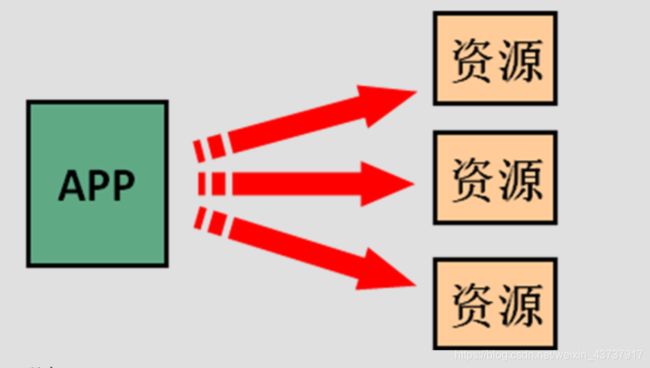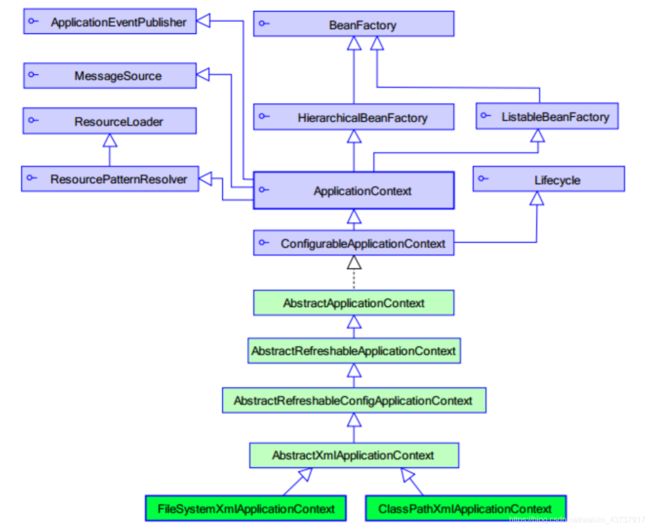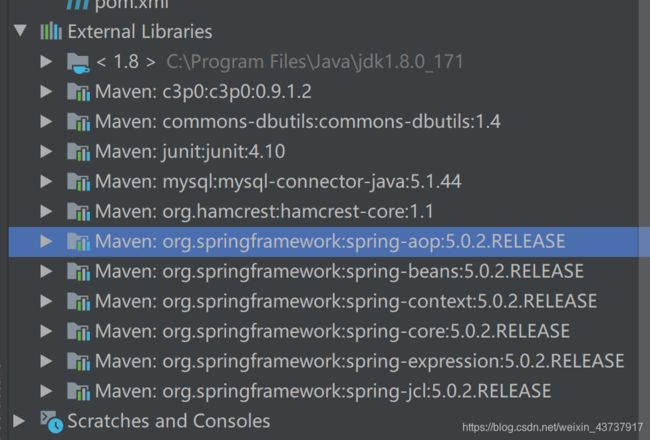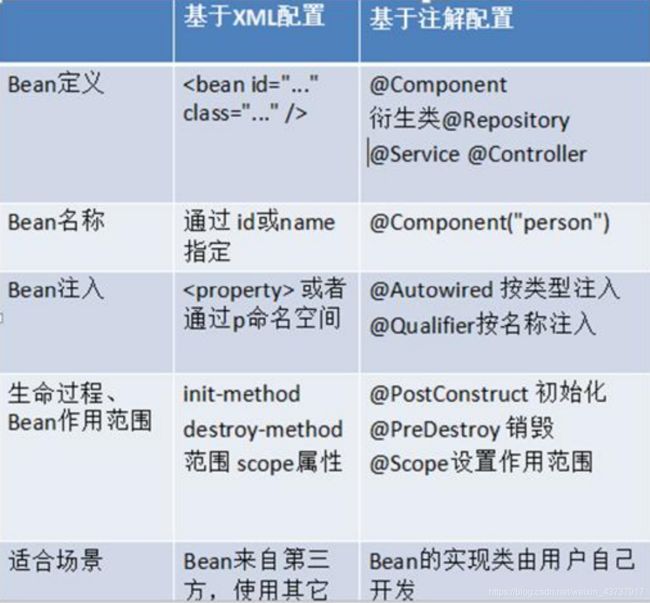Spring 深度学习 看这篇就够了(一)
Spring 深度学习 看这篇就够了(一)
- 第 1 章 spring概述
-
- 1.1 spring概述
-
- 1.1.1 spring 是什么
- 1.1.2 spring 的优势
- 1.1.3 spring 体系结构
- 第 2 章 IOC 的概念和作用
-
- 2.1 程序的耦合和解耦
-
- 2.1.1 什么是程序的耦合
- 2.1.2 解决程序耦合的思路
- 2.1.3 工厂模式解耦
- 2.1.4 控制反转 ( Inversion Of Control )
- 第 3 章 使用 spring 的 IOC 解决程序耦合
-
- 3.1 案例前期准备
-
- 3.1.1 spring 的开发包
- 3.1.2 创建一个Maven工程
- 3.1.3 创建业务层接口和实现类
- 3.1.4 创建持久层接口和实现类
- 3.2 基于XML的配置
-
- 3.2.1 创建配置文件
- 3.2.2 给文件导入约束
- 3.2.3 让 spring 管理资源,在配置文件中配置 service 和 dao
- 3.2.4 测试配置是否成功
- 3.3 spring 基于XML 的 IOC 细节
-
- 3.3.1 spring 中工厂的类结构图
-
- 3.3.1.1 spring 的核心容器
- 3.3.1.2 ApplicationContext 接口的实现类
- 3.3.2 IOC 中 bean 标签和管理对象细节
-
- 3.3.2.1 bean 标签
- 3.3.2.2 bean 生命周期
- 3.3.2.3 实例化 Bean 的三种方式
- 3.3.3 spring 的依赖注入
-
- 3.3.3.1 依赖注入的概念
- 3.3.3.2 构造函数注入
- 3.3.3.3 set 方法注入
- 3.3.3.4 注入集合属性
- 3.4 基于注解的 IOC 配置
-
- 3.4.1 明确 写在最前
- 3.4.2 案例 前期准备
-
- 3.4.2.1 新建Maven工程 添加依赖
- 3.4.2.2 创建数据库和编写实体类
- 3.4.2.3 编写持久层代码
- 3.4.2.4 编写 编写业务层代码
- 3.4.2.5 创建并编写配置文件
- 3.4.2.6 测试案例
- 3.4.2.7 分析测试了中的问题
- 3.4.3 基于注解的 IOC 配置
-
- 3.4.3.1 使用注解配置管理的资源
- 3.4.3.2 创建 spring 的 xml 配置文件并开启对注解的支持
- 3.4.4 常用注解
-
- 2.3.4.1 用于创建对象的
-
- 2.3.4.1.1 @Component
- 2.3.4.1.2 @Controller @Service @Repository
- 2.3.4.2 用于注入数据的
-
- 2.3.4.2.1 @Autowired
- 2.3.4.2.2 @Qualifier
- 2.3.4.2.3 @Resource
- 2.3.4.2.4 @Value
- 2.3.4.3 用于改变作用范围的
-
- 2.3.4.3.1 @scope
- 2.3.4.4 和生命周期相关的
-
- 2.3.4.4.1 @PostConstruct
- 2.3.4.4.1 @PreDestroy
- 3.4.5 关于 Spring 注解和 XML 的选择问题
- 3.5 spring 的纯注解配置
-
-
- 3.5.1 待改造的问题
- 3.5.2 与配置有关的注解
-
- 3.5.2.1 @Configuration
- 3.5.2.2 @ComponentScan
- 3.5.2.3 @Bean
- 3.5.2.4 @Import
- 3.5.2.5 @PropertySource
- 3.5.3 通过注解获取容器
-
- 第 4 章 spring 整合 Junit
-
- 4.1 测试类中的问题和解决思路
-
- 4.1.1 问题
- 4.1.2 解决思路分析
- 4.2 配置步骤
- 4.3 为什么不把测试类配到 xml 中
Spring 深度学习 看这篇就够了(二)
第 1 章 spring概述
新手小白,第一次写博客,若有不当之处,予以批评指正。
1.1 spring概述
1.1.1 spring 是什么
Spring 是分层的 Java SE/EE 应用 full-stack 轻量级开源框架,以 IoC(Inverse Of Control: 反转控制)和 AOP(Aspect Oriented Programming:面向切面编程)为内核,提供了展现层 Spring MVC 和持久层 Spring JDBC 以及业务层事务管理等众多的企业级应用技术,还能整合开源世界众多 著名的第三方框架和类库,逐渐成为使用最多的 Java EE 企业应用开源框架。
1.1.2 spring 的优势
方便解耦,简化开发
通过 Spring 提供的 IoC 容器,可以将对象间的依赖关系交由 Spring 进行控制,避免硬编码所造 成的过度程序耦合。用户也不必再为单例模式类、属性文件解析等这些很底层的需求编写代码,可 以更专注于上层的应用。
AOP 编程的支持
通过 Spring 的 AOP(Aspect Oriented Programming:面向切面编程) 功能,方便进行面向切面的编程,许多不容易用传统 OOP(Object Oriented Programming:面向对象程序设计) 实现的功能可以通过 AOP 轻松应付。
声明式事务的支持
可以将我们从单调烦闷的事务管理代码中解脱出来,通过声明式方式灵活的进行事务的管理, 提高开发效率和质量。
方便程序的测试
可以用非容器依赖的编程方式进行几乎所有的测试工作,测试不再是昂贵的操作,而是随手可 做的事情。
方便集成各种优秀框架
Spring 可以降低各种框架的使用难度,提供了对各种优秀框架(Struts、Hibernate、Hessian、Quartz 等)的直接支持。
降低 JavaEE API 的使用难度
Spring 对 JavaEE API(如 JDBC、JavaMail、远程调用等)进行了薄薄的封装层,使这些 API 的 使用难度大为降低。
Java 源码是经典学习范例
Spring 的源代码设计精妙、结构清晰、匠心独用,处处体现着大师对 Java 设计模式灵活运用以 及对 Java 技术的高深造诣。它的源代码无意是 Java 技术的最佳实践的范例。
1.1.3 spring 体系结构
第 2 章 IOC 的概念和作用
2.1 程序的耦合和解耦
2.1.1 什么是程序的耦合
耦合性(Coupling),也叫耦合度,是对模块间关联程度的度量。耦合的强弱取决于模块间接口的复杂性、调 用模块的方式以及通过界面传送数据的多少。模块间的耦合度是指模块之间的依赖关系,包括控制关系、调用关 系、数据传递关系。模块间联系越多,其耦合性越强,同时表明其独立性越差( 降低耦合性,可以提高其独立 性)。耦合性存在于各个领域,而非软件设计中独有的,但是我们只讨论软件工程中的耦合。 在软件工程中,耦合指的就是就是对象之间的依赖性。对象之间的耦合越高,维护成本越高。因此对象的设计 应使类和构件之间的耦合最小。软件设计中通常用耦合度和内聚度作为衡量模块独立程度的标准。划分模块的一个 准则就是高内聚低耦合。
它有如下分类:
(1)内容耦合。当一个模块直接修改或操作另一个模块的数据时,或一个模块不通过正常入口而转入另 一个模块时,这样的耦合被称为内容耦合。内容耦合是最高程度的耦合,应该避免使用之。
(2)公共耦合。两个或两个以上的模块共同引用一个全局数据项,这种耦合被称为公共耦合。在具有大 量公共耦合的结构中,确定究竟是哪个模块给全局变量赋了一个特定的值是十分困难的。
(3) 外部耦合 。一组模块都访问同一全局简单变量而不是同一全局数据结构,而且不是通过参数表传 递该全局变量的信息,则称之为外部耦合。
(4) 控制耦合 。一个模块通过接口向另一个模块传递一个控制信号,接受信号的模块根据信号值而进 行适当的动作,这种耦合被称为控制耦合。
(5)标记耦合 。若一个模块 A 通过接口向两个模块 B 和 C 传递一个公共参数,那么称模块 B 和 C 之间 存在一个标记耦合。
(6) 数据耦合。模块之间通过参数来传递数据,那么被称为数据耦合。数据耦合是最低的一种耦合形 式,系统中一般都存在这种类型的耦合,因为为了完成一些有意义的功能,往往需要将某些模块的输出数据作为另 一些模块的输入数据。
(7) 非直接耦合 。两个模块之间没有直接关系,它们之间的联系完全是通过主模块的控制和调用来实 现的。
总结:
耦合是影响软件复杂程度和设计质量的一个重要因素,在设计上我们应采用以下原则:如果模块间必须 存在耦合,就尽量使用数据耦合,少用控制耦合,限制公共耦合的范围,尽量避免使用内容耦合。 内聚与耦合 内聚标志一个模块内各个元素彼此结合的紧密程度,它是信息隐蔽和局部化概念的自然扩展。内聚是从 功能角度来度量模块内的联系,一个好的内聚模块应当恰好做一件事。它描述的是模块内的功能联系。耦合是软件 结构中各模块之间相互连接的一种度量,耦合强弱取决于模块间接口的复杂程度、进入或访问一个模块的点以及通 过接口的数据。 程序讲究的是低耦合,高内聚。就是同一个模块内的各个元素之间要高度紧密,但是各个模块之 间的相互依存度却要不那么紧密。
内聚和耦合是密切相关的,同其他模块存在高耦合的模块意味着低内聚,而高内聚的模块意味着该模块同其他 模块之间是低耦合。
在进行软件设计时,应力争做到高内聚,低耦合。
我们在开发中,有些依赖关系是必须的,有些依赖关系可以通过优化代码来解除的。
示例代码:
/**
* 账户的业务层实现类
* @author hz
* @blog http://www.huangzun.top
* @date 2020/3/3
*/
public class AccountServiceImpl implements IAccountService {
private IAccountDao accountDao = new AccountDaoImpl();
}
上面的代码表示:
业务层调用持久层,并且此时业务层在依赖持久层的接口和实现类。如果此时没有持久层实现类,编译将不能通过。这种编译期依赖关系,应该在我们开发中杜绝。我们需要优化代码解决。
再比如:
早期我们的 JDBC 操作,注册驱动时,我们为什么不使用 DriverManager 的 register 方法,而是采用 Class.forName 的方式?
/**
* 通过jdbc的案例演示程序的耦合
* @author hz
* @blog http://www.huangzun.top
* @date 2020/3/3
*/
public class JdbcDemo {
public static void main(String[] args) throws SQLException {
// 1、注册驱动
DriverManager.registerDriver(new com.mysql.jdbc.Driver());
// 2、获取连接
Connection conn = DriverManager.getConnection("","","");
// 3、获取数据库的预处理对象
String sql = "";
PreparedStatement pstm = conn.prepareStatement(sql);
// 4、执行SQL, 得到结果集
ResultSet rs = pstm.executeQuery();
// 5、遍历结果集
// 6、释放资源
rs.close();
pstm.close();
conn.close();
}
}
原因就是:
我们的类依赖了数据库的具体驱动类(MySQL),如果这时候更换了数据库品牌(比如 Oracle),需要修改源码来重新数据库驱动。这显然不是我们想要的。
2.1.2 解决程序耦合的思路
当是我们学习 jdbc 时,是通过反射来注册驱动的,代码如下:
Class.forName("com.mysql.jdbc.Driver"); //此处只是一个字符串
此时的好处是,我们的类中不再依赖具体的驱动类,此时就算删除 mysql 的驱动 jar 包,依然可以编译(运行就不要想了,没有驱动不可能运行成功的)。
实际开发中:
编译期不依赖,运行期依赖
同时,也产生了一个新的问题,mysql 驱动的全限定类名字符串是在 java 类中写死的,一旦要改还是要修改源码。
解决这个问题也很简单,使用配置文件配置。
1.使用反射创建对象,避免使用关键字new。
2.通过读取配置文件来获取要创建的对象全限定类名。
2.1.3 工厂模式解耦
在实际开发中我们可以把三层的对象都使用配置文件配置起来,当启动服务器应用加载的时候,让一个类中的 方法通过读取配置文件,把这些对象创建出来并存起来。在接下来的使用的时候,直接拿过来用就好了。
那么,这个读取配置文件,创建和获取三层对象的类就是工厂。
-
存哪儿?
由于我们是很多对象,肯定要找个集合来存。由于有查找需求,选 Map。
在应用加载时,创建一个 Map,用于存放三层对象。 我们把这个 map 称之为
容器。 -
工厂
工厂就是负责给我们从容器中获取指定对象的类。这时候我们获取对象的方式发生了改变。
2.1.4 控制反转 ( Inversion Of Control )
传统方法:
现在:
我们获取对象时,同时跟工厂要,有工厂为我们查找或者创建对象。是被动的
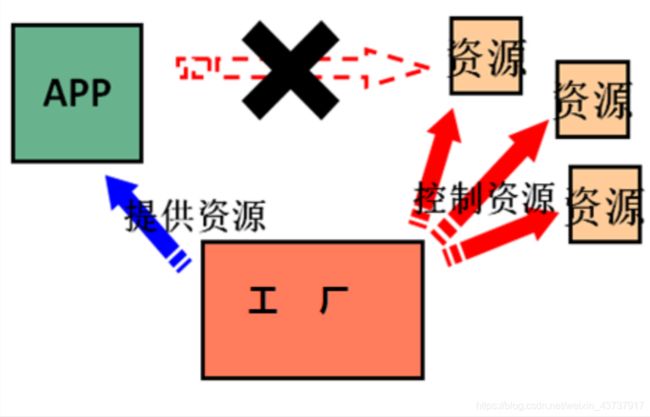
这种被动接收的方式获取对象的思想就是控制反转,它是 spring 框架的核心之一。
控制反转(Inversion of Control, IoC )把创建对象的权利交给框架,是框架的重要特征,并非面向对象编程的专用术语。它包括依赖注入(Dependency Injection,DI)和依赖查找(Dependency Lookup)。
明确 ioc 的作用:
削减计算机程序的耦合(解除我们代码中的依赖关系)
耦合:程序间的依赖关系(类之间的依赖关系,方法之间的依赖关系)
解耦: 降低程序之间的依赖关系
第 3 章 使用 spring 的 IOC 解决程序耦合
3.1 案例前期准备
我们使用的案例是,账户的业务层和持久层的依赖关系解决。。由于我们是使用 spring 解决依赖关系,并不是真正的要做增删改查操作,所以此时我们没必要写实体 类。
3.1.1 spring 的开发包
官网:http://spring.io/
下载地址: http://repo.springsource.org/libs-release-local/org/springframework/spring
特别说明:
spring5 版本是用 jdk8 编写的,所以要求我们的 jdk 版本是 8 及以上。
同时 tomcat 的版本要求 8.5 及以上。
3.1.2 创建一个Maven工程
在 pom.xml 导入spring依赖
<packaging>jarpackaging>
<dependencies>
<dependency>
<groupId>org.springframeworkgroupId>
<artifactId>spring-contextartifactId>
<version>${spring.version}version>
dependency>
dependencies>
3.1.3 创建业务层接口和实现类
/**
* 账户业务层的接口
* @author hz
* @blog http://www.huangzun.top
* @date 2020/3/3
*/
public interface IAccountService {
/**
* 模拟保存账户
*/
void saveAccount();
}
/**
* @author hz
* @blog http://www.huangzun.top
* @date 2020/3/3
*/
/**
* 账户的业务层实现类
*/
public class AccountServiceImpl implements IAccountService {
// 此处的依赖关系有待解决
private IAccountDao accountDao = new AccountDaoImpl();
public void saveAccount() {
accountDao.saveAccount();
}
}
3.1.4 创建持久层接口和实现类
/**
* 账户的持久层接口
* @author hz
* @blog http://www.huangzun.top
* @date 2020/3/3
*/
public interface IAccountDao {
/**
* 模拟保存账户
*/
void saveAccount();
}
/**
* 账户的持久层实现类
* @author hz
* @blog http://www.huangzun.top
* @date 2020/3/3
*/
public class AccountDaoImpl implements IAccountDao {
public void saveAccount(){
System.out.println("保存账户");
}
}
3.2 基于XML的配置
3.2.1 创建配置文件
1. 在src --> main --> resource 下新建bean.xml ( 名称不能为中文名 )
3.2.2 给文件导入约束
<beans xmlns="http://www.springframework.org/schema/beans"
xmlns:xsi="http://www.w3.org/2001/XMLSchema-instance"
xsi:schemaLocation="http://www.springframework.org/schema/beans
http://www.springframework.org/schema/beans/spring-beans.xsd">
beans>
3.2.3 让 spring 管理资源,在配置文件中配置 service 和 dao
<bean id="accountService" class="com.hz.service.impl.AccountServiceImpl">bean>
<bean id="accountDao" class="com.hz.dao.impl.AccountDaoImpl">bean>
3.2.4 测试配置是否成功
/**
* 模拟表现层,用于调用业务层
* @author hz
* @blog http://www.huangzun.top
* @date 2020/3/3
*/
public class client {
/**
* 获取Spring的IOC核心容器, 根据id获取对象
* ApplicationContext三个实现类:
* ClassPathXmlApplicationContext:可以加载类路径下的配置文件,要求文件必须在类路径下
* FileSystemXmlApplicationContext: 可以加载磁盘任意路径下的配置文件(必须有访问权限)
* AnnotationConfigApplicationContext: 用于读取注解创建容器
* @param args
*/
public static void main(String[] args) {
// 1、获取核心容器对象
ApplicationContext ac = new ClassPathXmlApplicationContext("bean.xml");
// 2、根据id获取Bean对象
IAccountService service = (IAccountService)ac.getBean("accountService");
IAccountDao dao = ac.getBean("accountDao", IAccountDao.class);
System.out.println(service);
System.out.println(dao);
}
}
3.3 spring 基于XML 的 IOC 细节
3.3.1 spring 中工厂的类结构图
3.3.1.1 spring 的核心容器
BeanFactory 才是 Spring 容器中的顶层接口。 ApplicationContext 是它的子接口。
BeanFactory 和 ApplicationContext 的区别:
ApplicationContext: 单列对象适用
它在构建核心容器时,创建对象采取的策略是采用立即加载的方式。
也就是说,一读取完配置文件马上就创建配置文件中配置对象
BeanFactory: 多例对象适用
它在构建核心容器时,创建对象采取的措施是采用延迟加载的方式。
也就是说,什么时候根据id获取对象了,什么时候才能真正创建对象
总结: 创建对象的时间点不一样
3.3.1.2 ApplicationContext 接口的实现类
获取Spring的IOC核心容器, 根据id获取对象
ApplicationContext三个实现类:
ClassPathXmlApplicationContext:
加载类路径下的配置文件,要求文件必须在类路径下 → 推荐使用这种
FileSystemXmlApplicationContext:
可以加载磁盘任意路径下的配置文件(必须有访问权限)
AnnotationConfigApplicationContext:
当我们使用注解配置容器对象时,需要使用此类来创建 spring 容器。它用来读取注解创建容器。
3.3.2 IOC 中 bean 标签和管理对象细节
3.3.2.1 bean 标签
作用:
用于配置对象让 spring 来创建的。
默认情况下它调用的是类中的无参构造函数。如果没有无参构造函数则不能创建成功。
属性:
id:给对象在容器中提供一个唯一标识。用于获取对象。
class:指定类的全限定类名。用于反射创建对象。默认情况下调用无参构造函数。
scope:指定对象的作用范围。
* singleton :默认值,单例的.
* prototype :多例的.
* request :WEB 项目中,Spring 创建一个 Bean 的对象,将对象存入到 request 域中.
* session :WEB 项目中,Spring 创建一个 Bean 的对象,将对象存入到 session 域中.
* global session :WEB 项目中,应用在 Portlet 环境.如果没有 Portlet 环境那么globalSession 相当于 session.
init-method:指定类中的初始化方法名称。
destroy-method:指定类中销毁方法名称。
3.3.2.2 bean 生命周期
bean对象的生命周期
单例对象:scope="singleton"
一个应用只有一个对象的实例。它的作用范围就是整个引用。
生命周期:
出生:当容器创建时出生
活着:只要容器存在,对象一直活着
死亡:容器销毁,对象消亡
总结:单例对象的生命周期和容器相同
多例对象:scope="prototype"
每次访问对象时,都会重新创建对象实例。
生命周期:
出生:当使用对象时,spring框架为我们创建
活着:对象只要在使用过程中,就一直活着
死亡:当对象长时间不用,且没有别的对象引用时,由Java的垃圾回收器回收
3.3.2.3 实例化 Bean 的三种方式
第一种方式: 使用默认无参构造函数
在spring的配置文件中使用bean标签,配以id和class之后,且没有其他属性和标签时,采用的就是默认构造函数创建bean对象,此时如果类中没有默认构造函数,则无法创建。
如果 bean 中没有默认无参构造函数,将会创建失败。
<bean id="accountService" class="com.hz.service.impl.AccountServiceImpl">bean>
第二种方式:spring 管理静态工厂-使用静态工厂的方法创建对象
此种方式是:
先把工厂的创建交给 spring 来管理。
在使用工厂的 bean 来调用里面的方法
factory-bean 属性:用于指定实例工厂 bean 的 id。
factory-method 属性:用于指定实例工厂中创建对象的方法。
/**
* 模拟一个工厂类,创建业务层实现类(该类可能存在于jar包中,我们无法通过修改源码的方式来提供默认构造函数)
* 此工厂创建对象,必须现有工厂实例对象,再调用方法
* @author hz
* @blog http://www.huangzun.top
* @date 2020/3/4
*/
public class InstanceFactory {
public IAccountService getAccountService(){
return new AccountServiceImpl();
}
}
<bean id="instanceFactory" class="com.hz.factory.InstanceFactory">bean>
<bean id="accountService" factory-bean="instanceFactory" factory-method="getAccountService">bean>
3.3.3 spring 的依赖注入
3.3.3.1 依赖注入的概念
依赖注入( Dependency Injection, DI),在当前类需要用到其他类的对象,有spring为我们提供,我们只需要在配置文件中说明依赖关系的维护。它是 spring 框架核心 ioc 的具体实现。
我们的程序在编写时,通过控制反转( ioc )把对象的创建交给了 spring,但是代码中不可能出现没有依赖的情况。
ioc 解耦只是降低他们的依赖关系,但不会消除。例如:我们的业务层仍会调用持久层的方法。
那这种业务层和持久层的依赖关系,在使用 spring 之后,就让 spring 来维护了。 简单的说,就是坐等框架把持久层对象传入业务层,而不用我们自己去获取。
3.3.3.2 构造函数注入
顾名思义,就是使用类中的构造函数,给成员变量赋值。注意,赋值的操作不是我们自己做的,而是通过配置 的方式,让 spring 框架来为我们注入。
/**
* 账户的业务层实现类
* @author hz
* @blog http://www.huangzun.top
* @date 2020/3/3
*/
public class AccountServiceImpl implements IAccountService {
private String name;
private Integer age;
private Date birthday;
public AccountServiceImpl(String name, Integer age, Date birthday) {
this.name = name;
this.age = age;
this.birthday = birthday;
}
public void saveAccount() {
System.out.println("service-->saveAccount" + name + ", " + age + ", " + birthday);
}
}
<bean id="accountService" class="com.hz.service.impl.AccountServiceImpl">
<constructor-arg name="name" value="张三">constructor-arg>
<constructor-arg name="age" value="18">constructor-arg>
<constructor-arg name="birthday" ref="now" >constructor-arg>
bean>
<bean id="now" class="java.util.Date">bean>
3.3.3.3 set 方法注入
顾名思义,就是在类中提供需要注入成员的 set 方法。
/**
* 账户的业务层实现类
*/
public class AccountServiceImpl implements IAccountService {
private String name;
private Integer age;
private Date birthday;
public void setName(String name) {
this.name = name;
}
public void setAge(Integer age) {
this.age = age;
}
public void setBirthday(Date birthday) {
this.birthday = birthday;
}
public void saveAccount() {
System.out.println("service-->saveAccount " + name + ", " + age + ", " + birthday);
}
}
<bean id="accountService" class="com.hz.service.impl.AccountServiceImpl">
<property name="name" value="张三">property>
<property name="age" value="18">property>
<property name="birthday" ref="now">property>
bean>
<bean id="now" class="java.util.Date">bean>
3.3.3.4 注入集合属性
顾名思义,就是给类中的集合成员传值,它用的也是set方法注入的方式,只不过变量的数据类型都是集合。
public class AccountServiceImpl implements IAccountService {
private String [] myStrs;
private List<String> myList;
private Set<String> mySet;
private Map<String, String> myMap;
private Properties myPros;
public void setMyStrs(String[] myStrs) {
this.myStrs = myStrs;
}
public void setMyList(List<String> myList) {
this.myList = myList;
}
public void setMySet(Set<String> mySet) {
this.mySet = mySet;
}
public void setMyMap(Map<String, String> myMap) {
this.myMap = myMap;
}
public void setMyPros(Properties myPros) {
this.myPros = myPros;
}
public void saveAccount() {
System.out.println(Arrays.toString(myStrs));
System.out.println(myList);
System.out.println(mySet);
System.out.println(myMap);
System.out.println(myPros);
}
}
<bean id="accountService" class="com.hz.service.impl.AccountServiceImpl">
<property name="myStrs">
<set>
<value>AAAvalue>
<value>BBBvalue>
set>
property>
<property name="myList">
<array>
<value>CCCvalue>
<value>DDDvalue>
array>
property>
<property name="mySet">
<array>
<value>CCCvalue>
<value>DDDvalue>
array>
property>
<property name="myMap">
<map>
<entry key="test1" value="test1">entry>
<entry key="test2">
<value>test2value>
entry>
map>
property>
<property name="myPros">
<props>
<prop key="test">prosprop>
props>
property>
bean>
3.4 基于注解的 IOC 配置
3.4.1 明确 写在最前
学习基于注解的 IoC 配置,大家脑海里首先得有一个认知,即注解配置和 xml 配置要实现的功能都是一样 的,都是要降低程序间的耦合。只是配置的形式不一样。
关于实际的开发中到底使用xml还是注解,每家公司有着不同的使用习惯。所以这两种配置方式我们都需要掌握。
3.4.2 案例 前期准备
使用 spring 的 IoC 的实现账户的 CRUD
3.4.2.1 新建Maven工程 添加依赖
版本自行选择
<packaging>jarpackaging>
<dependencies>
<dependency>
<groupId>org.springframeworkgroupId>
<artifactId>spring-contextartifactId>
<version>${spring.version}version>
dependency>
<dependency>
<groupId>commons-dbutilsgroupId>
<artifactId>commons-dbutilsartifactId>
<version>1.4version>
dependency>
<dependency>
<groupId>mysqlgroupId>
<artifactId>mysql-connector-javaartifactId>
<version>5.1.44version>
dependency>
<dependency>
<groupId>c3p0groupId>
<artifactId>c3p0artifactId>
<version>0.9.1.2version>
dependency>
<dependency>
<groupId>junitgroupId>
<artifactId>junitartifactId>
<version>4.10version>
dependency>
dependencies>
3.4.2.2 创建数据库和编写实体类
新建数据库:
create table account(
id int primary key auto_increment,
name varchar(40),
money float
)character set utf8 collate utf8_general_ci;
insert into account(name,money) values('aaa',1000);
insert into account(name,money) values('bbb',1000);
insert into account(name,money) values('ccc',1000);
编写实体类:
/**
* 账户的实体类
* @author hz
* @blog http://www.huangzun.top
* @date 2020/3/7
*/
public class Account implements Serializable {
private Integer id;
private String name;
private Float money;
@Override
public String toString() {
return "Account{" +
"id=" + id +
", name='" + name + '\'' +
", money=" + money +
'}';
}
public Integer getId() {
return id;
}
public void setId(Integer id) {
this.id = id;
}
public String getName() {
return name;
}
public void setName(String name) {
this.name = name;
}
public Float getMoney() {
return money;
}
public void setMoney(Float money) {
this.money = money;
}
}
3.4.2.3 编写持久层代码
/**
* 账户的持久层接口
* @author hz
* @blog http://www.huangzun.top
* @date 2020/3/7
*/
public interface IAccountDao {
/**
* 查询所有
* @return
*/
List<Account> findAllAccount();
/**
* 查询一个
* @return
*/
Account findAccountById(Integer accountId);
/**
* 保存账户
* @param account
*/
void saveAccount(Account account);
/**
* 更新账户
* @param account
*/
void updateAccount(Account account);
/**
* 删除账户
* @param accountId
*/
void deleteAccount(Integer accountId);
}
持久层实现类
/**
* 账户的持久层实现类
* @author hz
* @blog http://www.huangzun.top
* @date 2020/3/7
*/
public class AccountDaoImpl implements IAccountDao {
private QueryRunner runner;
public void setRunner(QueryRunner runner) {
this.runner = runner;
}
@Override
public List<Account> findAllAccount() {
try{
return runner.query("select * from account", new BeanListHandler<>(Account.class));
}catch (Exception e){
throw new RuntimeException(e);
}
}
@Override
public Account findAccountById(Integer accountId) {
try {
return runner.query("select * from account where id = ?", new BeanHandler<>(Account.class), accountId);
} catch (Exception e) {
throw new RuntimeException(e);
}
}
@Override
public void saveAccount(Account account) {
try{
runner.update("insert into account(name,money)values(?,?)", account.getName(),account.getMoney());
}catch (Exception e){
throw new RuntimeException(e);
}
}
@Override
public void updateAccount(Account account) {
try{
runner.update("update account set name=?,money=? where id=?", account.getName(),account.getMoney());
}catch (Exception e){
throw new RuntimeException(e);
}
}
@Override
public void deleteAccount(Integer accountId) {
try{
runner.update("delete from account where id=?", accountId);
}catch (Exception e){
throw new RuntimeException(e);
}
}
}
3.4.2.4 编写 编写业务层代码
/**
* 账户的业务层接口
* @author hz
* @blog http://www.huangzun.top
* @date 2020/3/7
*/
public interface IAccountService {
/**
* 查询所有
* @return
*/
List<Account> findAllAccount();
/**
* 查询一个
* @return
*/
Account findAccountById(Integer accountId);
/**
* 保存账户
* @param account
*/
void saveAccount(Account account);
/**
* 更新账户
* @param account
*/
void updateAccount(Account account);
/**
* 删除账户
* @param accountId
*/
void deleteAccount(Integer accountId);
}
业务层实现类
/**
* 账户的业务层实现类
* @author hz
* @blog http://www.huangzun.top
* @date 2020/3/7
*/
public class AccountServiceImpl implements IAccountService {
private IAccountDao accountDao;
public void setAccountDao(IAccountDao accountDao) {
this.accountDao = accountDao;
}
@Override
public List<Account> findAllAccount() {
return accountDao.findAllAccount();
}
@Override
public Account findAccountById(Integer accountId) {
return accountDao.findAccountById(accountId);
}
@Override
public void saveAccount(Account account) {
accountDao.saveAccount(account);
}
@Override
public void updateAccount(Account account) {
accountDao.updateAccount(account);
}
@Override
public void deleteAccount(Integer accountId) {
accountDao.deleteAccount(accountId);
}
}
3.4.2.5 创建并编写配置文件
在 src --> main --> resources 添加配置文件
<beans xmlns="http://www.springframework.org/schema/beans"
xmlns:xsi="http://www.w3.org/2001/XMLSchema-instance"
xsi:schemaLocation="http://www.springframework.org/schema/beans
http://www.springframework.org/schema/beans/spring-beans.xsd">
<bean id="accountService" class="com.hz.service.impl.AccountServiceImpl">
<property name="accountDao" ref="accountDao">property>
bean>
<bean id="accountDao" class="com.hz.dao.impl.AccountDaoImpl">
<property name="runner" ref="runner">property>
bean>
<bean id="runner" class="org.apache.commons.dbutils.QueryRunner" scope="prototype">
<constructor-arg name="ds" ref="dateSource">constructor-arg>
bean>
<bean id="dateSource" class="com.mchange.v2.c3p0.ComboPooledDataSource">
<property name="driverClass" value="com.mysql.jdbc.Driver">property>
<property name="jdbcUrl" value="jdbc:mysql://localhost:3306/eesy?useUnicode=true&characterEncoding=utf8">property>
<property name="user" value="root">property>
<property name="password" value="root">property>
bean>
beans>
3.4.2.6 测试案例
添加测试代码
/**
* 测试代码
* @author hz
* @blog http://www.huangzun.top
* @date 2020/3/7
*/
public class AccountServiceTest {
@Test
public void TestFindAll(){
// 1. 获取容器
ApplicationContext ac = new ClassPathXmlApplicationContext("bean.xml");
// 2. 得到业务对象
IAccountService as = ac.getBean("accountService", IAccountService.class);
List<Account> accounts = as.findAllAccount();
for (Account account : accounts){
System.out.println(account);
}
}
@Test
public void TestFindOne(){
// 1. 获取容器
ApplicationContext ac = new ClassPathXmlApplicationContext("bean.xml");
// 2. 得到业务对象
IAccountService as = ac.getBean("accountService", IAccountService.class);
Account account = as.findAccountById(1);
System.out.println(account);
}
@Test
public void TestSave(){
// 1. 获取容器
ApplicationContext ac = new ClassPathXmlApplicationContext("bean.xml");
// 2. 得到业务对象
IAccountService as = ac.getBean("accountService", IAccountService.class);
Account account = new Account();
account.setName("save");
account.setMoney(3000.0f);
as.saveAccount(account);
}
@Test
public void TestUpdate(){
// 1. 获取容器
ApplicationContext ac = new ClassPathXmlApplicationContext("bean.xml");
// 2. 得到业务对象
IAccountService as = ac.getBean("accountService", IAccountService.class);
Account account = as.findAccountById(4);
account.setName("update");
as.updateAccount(account);
}
@Test
public void TestDelete(){
// 1. 获取容器
ApplicationContext ac = new ClassPathXmlApplicationContext("bean.xml");
// 2. 得到业务对象
IAccountService as = ac.getBean("accountService", IAccountService.class);
as.deleteAccount(4);
}
}
3.4.2.7 分析测试了中的问题
通过上面的测试类,我们可以看出,每个测试方法都重新获取了一次 spring 的核心容器,造成了不必要的重复代码,增加了我们开发的工作量。这种情况,在开发中应该避免发生。
可能有人想到,我们把容器的获取定义到类中去。例如:
/**
* 方法一
* 测试代码
* @author hz
* @blog http://www.huangzun.top
* @date 2020/3/7
*/
public class AccountServiceTest {
private ApplicationContext ac;
private IAccountService as;
@Before
public void init(){
// 1. 获取容器
ac = new ClassPathXmlApplicationContext("bean.xml");
// 2. 得到业务对象
as = ac.getBean("accountService", IAccountService.class);
}
@Test
public void TestFindAll(){
// 1. 获取容器
ApplicationContext ac = new ClassPathXmlApplicationContext("bean.xml");
// 2. 得到业务对象
IAccountService as = ac.getBean("accountService", IAccountService.class);
// 3. 执行方法
List<Account> accounts = as.findAllAccount();
for (Account account : accounts){
System.out.println(account);
}
}
}
/**
* 方法二
* 测试代码
* @author hz
* @blog http://www.huangzun.top
* @date 2020/3/7
*/
public class AccountServiceTest {
private ApplicationContext ac = new ClassPathXmlApplicationContext("bean.xml");
private IAccountService as ac.getBean("accountService", IAccountService.class);
}
这种方式虽然能解决问题,但是扔需要我们自己写代码来获取容器。
能不能测试时直接就编写测试方法,而不需要手动编码来获取容器呢?
3.4.3 基于注解的 IOC 配置
我们在讲解注解配置时,采用上一章节的案例,把 spring 的 xml 配置内容改为使用注解逐步实现。
注意:
3.4.3.1 使用注解配置管理的资源
/**
* 账户的业务层实现类
* @author hz
* @blog http://www.huangzun.top
* @date 2020/3/7
*/
@Service("accountService")
public class AccountServiceImpl implements IAccountService {
@Autowired
private IAccountDao accountDao;
@Override
public List<Account> findAllAccount() {
return accountDao.findAllAccount();
}
@Override
public Account findAccountById(Integer accountId) {
return accountDao.findAccountById(accountId);
}
@Override
public void saveAccount(Account account) {
accountDao.saveAccount(account);
}
@Override
public void updateAccount(Account account) {
accountDao.updateAccount(account);
}
@Override
public void deleteAccount(Integer accountId) {
accountDao.deleteAccount(accountId);
}
}
/**
* 账户的持久层实现类
* @author hz
* @blog http://www.huangzun.top
* @date 2020/3/7
*/
@Repository("accountDao")
public class AccountDaoImpl implements IAccountDao {
@Autowired
private QueryRunner runner;
@Override
public List<Account> findAllAccount() {
try{
return runner.query("select * from account", new BeanListHandler<>(Account.class));
}catch (Exception e){
throw new RuntimeException(e);
}
}
@Override
public Account findAccountById(Integer accountId) {
try {
return runner.query("select * from account where id = ?", new BeanHandler<>(Account.class), accountId);
} catch (Exception e) {
throw new RuntimeException(e);
}
}
@Override
public void saveAccount(Account account) {
try{
runner.update("insert into account(name,money)values(?,?)", account.getName(),account.getMoney());
}catch (Exception e){
throw new RuntimeException(e);
}
}
@Override
public void updateAccount(Account account) {
try{
runner.update("update account set name=?,money=? where id=?", account.getName(),account.getMoney());
}catch (Exception e){
throw new RuntimeException(e);
}
}
@Override
public void deleteAccount(Integer accountId) {
try{
runner.update("delete from account where id=?", accountId);
}catch (Exception e){
throw new RuntimeException(e);
}
}
}
3.4.3.2 创建 spring 的 xml 配置文件并开启对注解的支持
<beans xmlns="http://www.springframework.org/schema/beans"
xmlns:xsi="http://www.w3.org/2001/XMLSchema-instance"
xmlns:context="http://www.springframework.org/schema/context"
xsi:schemaLocation="http://www.springframework.org/schema/beans
http://www.springframework.org/schema/beans/spring-beans.xsd
http://www.springframework.org/schema/context
http://www.springframework.org/schema/context/spring-context.xsd">
<context:component-scan base-package="com.hz">context:component-scan>
<bean id="runner" class="org.apache.commons.dbutils.QueryRunner" scope="prototype">
<constructor-arg name="ds" ref="dateSource">constructor-arg>
bean>
<bean id="dateSource" class="com.mchange.v2.c3p0.ComboPooledDataSource">
<property name="driverClass" value="com.mysql.jdbc.Driver">property>
<property name="jdbcUrl" value="jdbc:mysql://localhost:3306/eesy?useUnicode=true&characterEncoding=utf8">property>
<property name="user" value="root">property>
<property name="password" value="root">property>
bean>
beans>
3.4.4 常用注解
2.3.4.1 用于创建对象的
相当于:
2.3.4.1.1 @Component
作用:
把资源让 spring 来管理。相当于在 xml 中配置一个 bean。
属性:
value:指定 bean 的 id。如果不指定 value 属性,默认 bean 的 id 是当前类的类名。首字母小写。
2.3.4.1.2 @Controller @Service @Repository
他们三个注解都是针对一个的衍生注解,他们的作用及属性都是一模一样的。
他们只不过是提供了更加明确的语义化。
@Controller:一般用于表现层的注解。
@Service:一般用于业务层的注解。
@Repository:一般用于持久层的注解。
细节:如果注解中有且只有一个属性要赋值时,且名称是 value,value 在赋值是可以不写。
2.3.4.2 用于注入数据的
相当于:
2.3.4.2.1 @Autowired
作用:
自动按照类型注入。当使用注解注入属性时,set 方法可以省略。它只能注入其他 bean 类型。当有多个
类型匹配时,使用要注入的对象变量名称作为 bean 的 id,在 spring 容器查找,找到了也可以注入成功。找不到
就报错。
2.3.4.2.2 @Qualifier
作用:
在自动按照类型注入的基础之上,再按照 Bean 的 id 注入。它在给字段注入时不能独立使用,必须和
@Autowire 一起使用;但是给方法参数注入时,可以独立使用。
属性:
value:指定 bean 的 id。
2.3.4.2.3 @Resource
作用:
直接按照 Bean 的 id 注入。它也只能注入其他 bean 类型。
属性:
name:指定 bean 的 id。
2.3.4.2.4 @Value
作用:
注入基本数据类型和 String 类型数据的
属性:
value:用于指定值
2.3.4.3 用于改变作用范围的
相当于:
2.3.4.3.1 @scope
作用:
指定 bean 的作用范围。
属性:
value:指定范围的值。
取值:
singleton:单例的(默认值)
prototype:多例的
request:作用于web应用的请求范围
session:作用于web应用的会话范围
global-session:作用于集群环境的会话范围(全局会话范围),当不是集群环境时,他就是session
2.3.4.4 和生命周期相关的
相当于:
2.3.4.4.1 @PostConstruct
用于指定初始化方法。
2.3.4.4.1 @PreDestroy
用于指定销毁方法。
3.4.5 关于 Spring 注解和 XML 的选择问题
注解的优势:
配置简单,维护方便(我们找到类,就相当于找到了对应的配置)。
XML 的优势:
修改时,不用改源码。不涉及重新编译和部署。 Spring 管理 Bean 方式的比较:
3.5 spring 的纯注解配置
写到此处,基于注解的 IoC 配置已经完成,但是大家都发现了一个问题:我们依然离不开 spring 的 xml 配 置文件,那么能不能不写这个 bean.xml,所有配置都用注解来实现呢?
3.5.1 待改造的问题
我们发现,之所以我们现在离不开 xml 配置文件,是因为我们有一句很关键的配置
<context:component-scan base-package="com.hz">context:component-scan>
<bean id="runner" class="org.apache.commons.dbutils.QueryRunner" scope="prototype">
<constructor-arg name="ds" ref="dateSource">constructor-arg>
bean>
<bean id="dateSource" class="com.mchange.v2.c3p0.ComboPooledDataSource">
<property name="driverClass" value="com.mysql.jdbc.Driver">property>
<property name="jdbcUrl" value="jdbc:mysql://localhost:3306/eesy?useUnicode=true&characterEncoding=utf8">property>
<property name="user" value="root">property>
<property name="password" value="root">property>
bean>
3.5.2 与配置有关的注解
3.5.2.1 @Configuration
作用:
用于指定当前类是一个 spring 配置类,当创建容器时会从该类上加载注解。获取容器时需要使用
AnnotationApplicationContext(有@Configuration 注解的类.class)。
属性:
value:用于指定配置类的字节码
3.5.2.2 @ComponentScan
作用:
用于指定 spring 在初始化容器时要扫描的包。作用和在 spring 的 xml 配置文件中的:
3.5.2.3 @Bean
作用:
该注解只能写在方法上,表明使用此方法创建一个对象,并且放入 spring 容器。
属性:
name:给当前@Bean 注解方法创建的对象指定一个名称(即 bean 的 id)。
3.5.2.4 @Import
作用:
用于导入其他的配置类
属性:
value: 用于指定其他配置类的字节码
当我们使用Import的注解之后,有Import注解的类就是父配置类,导入的就是子配置类
3.5.2.5 @PropertySource
作用:
用于加载.properties 文件中的配置。例如我们配置数据源时,可以把连接数据库的信息写到properties 配置文件中,就可以使用此注解指定 properties 配置文件的位置。
属性:
value:用于指定 properties 文件位置。如果是在类路径下,需要写上 classpath:
关键词:classpath, 表示类路径下
示例代码
/**
* @author hz
* @blog http://www.huangzun.top
* @date 2020/3/7
*/
@Configuration
@ComponentScan(basePackages = "com.hz")
@Import(JdbcConfig.class)
@PropertySource("classpath: jdbcConfig.properties")
public class SpringConfiguration {
/**
* 用于创建一个QueryRunner对象
* @param dataSource
* @return
*/
@Bean(name = "runner")
public QueryRunner createQueryRunner(DataSource dataSource){
return new QueryRunner(dataSource);
}
}
/**
* @author hz
* @blog http://www.huangzun.top
* @date 2020/3/7
*/
public class JdbcConfig {
@Value("${jdbc.driver}")
private String driver;
@Value("${jdbc.url}")
private String url;
@Value("${jdbc.username}")
private String username;
@Value("jdbc.password")
private String password;
/**
* 创建数据源对象
* @return
*/
@Bean(name = "dataSource")
public DataSource createDataSource(){
try{
ComboPooledDataSource ds = new ComboPooledDataSource();
ds.setDriverClass(driver);
ds.setJdbcUrl(url);
ds.setUser(username);
ds.setPassword(password);
return ds;
} catch (Exception e) {
throw new RuntimeException(e);
}
}
}
在 resources 添加文件 JdbcConfig.properties
jdbc.driver=com.mysql.jdbc.Driver
jdbc.url=dbc:mysql://localhost:3306/eesy
jdbc.username=root
jdbc.password=root
3.5.3 通过注解获取容器
ApplicationContext ac =new AnnotationConfigApplicationContext(SpringConfiguration.class);
第 4 章 spring 整合 Junit
当使用spring 5.x版本时,要求Junit版本4.12 以上
4.1 测试类中的问题和解决思路
4.1.1 问题
在测试类中,每个测试方法都有以下两行代码
这两行代码的作用是获取容器,如果不写的话,直接会提示空指针异常。所以又不能轻易删掉。
ApplicationContext ac = new ClassPathXmlApplicationContext("bean.xml");
IAccountService as = ac.getBean("accountService", IAccountService.class);
4.1.2 解决思路分析
针对上述问题,我们需要的是程序能自动帮我们创建容器。一旦程序能自动为我们创建 spring 容器,我们就无须手动创建了,问题也就解决了。
我们都知道,junit 单元测试的原理(在 web 阶段课程中讲过),但显然,junit 是无法实现的,因为它自己都无法知晓我们是否使用了
spring 框架,更不用说帮我们创建 spring 容器了。不过好在,junit 给我们暴露了一个注解,可以让我们替换掉它的运行器。
这时,我们需要依靠 spring 框架,因为它提供了一个运行器,可以读取配置文件(或注解)来创建容器。我们只需要告诉它配置文件在哪就行了。
4.2 配置步骤
1 添加依赖
<dependency>
<groupId>junitgroupId>
<artifactId>junitartifactId>
<version>4.10version>
dependency>
2 使用@RunWith 注解替换原有运行器
@RunWith(SpringJUnit4ClassRunner.class)
public class AccountServiceTest {
}
3 使用@ContextConfiguration 指定 spring 配置文件的位置
@ContextConfiguration 注解:
locations 属性:用于指定配置文件的位置。如果是类路径下,需要用 classpath:表明
classes 属性:用于指定注解的类。当不使用 xml 配置时,需要用此属性指定注解类的位置。
@RunWith(SpringJUnit4ClassRunner.class)
@ContextConfiguration(classes = SpringConfiguration.class)
public class AccountServiceTest {
}
4 使用@Autowired 给测试类中的变量注入数据
@RunWith(SpringJUnit4ClassRunner.class)
@ContextConfiguration(classes = SpringConfiguration.class)
public class AccountServiceTest {
@Autowired
private IAccountService as ;
}
4.3 为什么不把测试类配到 xml 中
在解释这个问题之前,先解除大家的疑虑,配到 XML 中能不能用呢?
答案是肯定的,没问题,可以使用。
那么为什么不采用配置到 xml 中的方式呢?
这个原因是这样的:
第一:当我们在 xml 中配置了一个 bean,spring 加载配置文件创建容器时,就会创建对象。
第二:测试类只是我们在测试功能时使用,而在项目中它并不参与程序逻辑,也不会解决需求上的问题,所以创建完了,并没有使用。那么存在容器中就会造成资源的浪费。
所以,基于以上两点,我们不应该把测试配置到 xml 文件中。
Spring 深度学习 看这篇就够了(二)

